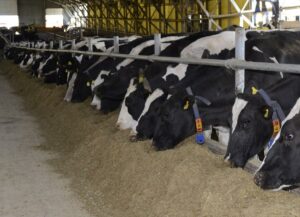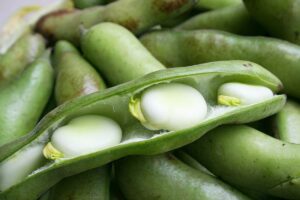María Villagrasa
Cereals are an important part of feeding dairy cows as they are a safe source of metabolizable energy. However, if the starch contained in grains is fed in excess, it can cause some health issues such as subclinical rumen acidosis.
In the search for alternative feed sources for livestock, there is increased interest in ingredients such as bakery meal, a co-product based on wheat meal obtained from what bakeries and supermarkets do not sell, such as biscuits, bread, doughnuts, chocolate, etc.
The composition of bakery meal is very variable depending on the original raw material. Its production process is simple: the ingredients, which must be well preserved and containing no contaminants, are collected, dried, ground and then mixed to obtain the final product.
From a nutritional standpoint bakery meal is different from cereal grains: it is rich in carbohydrates (55-62% starch plus sugars, dry matter basis; DM) and fat (7-10%) and as a result it’s highly palatable. Its protein content is low (8-11%), however the availability of its amino acids is high.
An important aspect to consider when feeding bakery meal to cattle is related to the chemical changes that occur during processing as grinding or heating could modify ruminal starch degradation and affect rumen health.
A study (Kaltenegger et al., 2020) was conducted to assess the effects on DM intake, milk production and rumen pH of replacing cereal grains with different amounts of bakery meal.
A total of 24 lactating Simmental cows were distributed in three groups and fed three different diets:
- Control: 0% bakery meal and 30% cereals
- Group 15CF: 15% bakery mealplus 15% cereals
- Group 30CF: 30% bakery mealand 0% cereals
Diets were offered as a blended whole serving and contained 50% concentrate, 25% corn silage and 25% grass silage (DM basis). The cereals used were wheat and triticale. Table 1 shows the nutritional composition of the diets, while the composition of bakery meal and cereal diet is reported in Table 2.
As shown in Table 1, and compared to the control diet, adding bakery meal increased sugars, from 4.50 to 5.97%, and fats from 2.40 to 4.00%.
From Table 2 it is observed that the main differences between bakery meal and cereals are in fat and sugars. In the first case, bakery meal has 10.9%, wheat 1.90% and triticale 5.50%; while for sugars, bakery meal has 10.6%, wheat 2.80% and triticale 4.90%.
Daily milk production increased 4.5 kg by adding bakery meal
Dry matter intake of cows fed bakery meal increased linearly compared to the control group, from 23.0 kg/day in the control to 24.7 kg/day in 15CF, and 24.9 kg/day in 30CF.
Furthermore, increasing bakery meal concentration in the diets increased daily milk production linearly compared to the control (30.6 vs 35.1 kg), and energy-corrected milk (29.4 vs. 34.3 kg/day).
Milk composition was also affected by bakery meal addition with fat content increasing (3.59 vs. 3.90%), and protein decreasing (3.63 vs. 3.51%). Milk protein production also decreased (1.20 vs. 1.14 kg/day), but the other components were not affected by the inclusion of bakery meal. The fat/protein ratio increased linearly by including more bakery meal in the diet (1.01 vs. 1.09). The concentration of milk urea nitrogen decreased linearly with bakery meal inclusion (27.1 vs. 20.2 mg/dL).
Glucose and insulin concentration decreased by increasing bakery meal
Glucose concentration decreased linearly throughout the day in cows fed bakery meal. This result is explained because it is possible that bakery meal caused less propionate production in the rumen and, since propionate is the main precursor to glucose, it was reduced by increasing the concentration of bakery meal.
On the other hand, plasma insulin concentration also decreased linearly with the inclusion of bakery meal. The reduction of both glucose and insulin by increasing bakery meal was associated with the linear increase of non-esterified fatty acids (NEFA) and beta-hydroxybutyrate (BHB) in plasma. Despite this increase when considering absolute levels, the concentrations of both compounds was low in this study (NEFA: 0.024–0.049 mmol/l; BHB: 0.18–0.58 mmol/l).
Bakery meal reduced risk of subclinical ruminal acidosis
The average rumen pH went from 5.91 in the control group to 5.98 in the group fed the least amount of bakery meal, and 5.93 in the last group.
As mentioned above the processing of bakery meal can affect rumen health and cause subclinical ruminal acidosis, a disorder that occurs when ruminal pH is below 5.8, during 284 to 475 minutes/day. Contrary to what was expected, in this study this time was 569 min/day in control cows, while 381 min/day in the group with the least amount of bakery meal; this suggests that the former had greater risk of inducing subclinical ruminal acidosis.
This digestive disorder occurs as a result of cereal-rich diets, that contain a lot of starch and little fiber. Therefore, it’s possible that the length of time pH was below 5.8 in the control group was due to the higher starch content in their diet. In that case, the cereals in the control diet were wheat and triticale which have the highest ruminal starch degradability, which could also have exceeded the buffering capacity of rumen.
Conclusion
These results indicate that including up to 30% bakery meal in dairy cow diets increased DM intake, milk production (at 4.5 kg/day) and milk fat content and reduced the risk of subclinical ruminal acidosis.
Reference
Kaltenegger, Anna & Humer, Elke & Stauder, Alexander & Zebeli, Qendrim. (2020). Feeding of bakery by-products in the replacement of grains enhanced milk performance, modulated blood metabolic profile, and lowered the risk of rumen acidosis in dairy cows. Journal of Dairy Science. 103. 10.3168/jds.2020-18425.
© 2020 Dairy Knowledge Center. All Rights Reserved.












